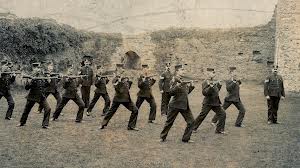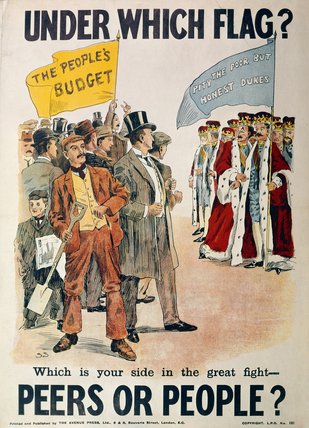by Pete Goddard and Atul Hatwal
After the January 1910 election, Labour had, if anything, moved slightly backwards. But that was as nothing compared to the disaster the Liberals had experienced.
They had asked the country “who governs this nation: the peers or the people?” The voters of Britain had responded saying, “democracy is nice but ooh, feel that lovely soft ermine and listen to those posh voices. Can we phone a friend?”
From 1906, when the Liberals enjoyed a landslide of 397 seats with a majority of more than 130 over all the other parties combined, they had slumped to just 274 seats – smaller than the Tories.
Parliament was hung (not “like a horse” but “like a legislative body where no clear majority exists on any side”) and the Liberal government was now a coalition, with the Liberals reliant on the support of the Irish nationalists to retain a majority in the House of Commons. If they could keep Labour on side too, so much the better.
The inconclusive nature of the election result meant another poll was surely around the corner.
That made for a tough year for Labour, waiting for this inevitable election. It was particularly hard for one George Barnes. He was the man in the hot seat as the new leader of the Labour party, a job that came with few perks and a dress code that included a pair of trousers with “kick here” embroidered on the seat.
Barnes had not really expected or intended to get the top job. Ramsay Macdonald was tipped as the man to take over from Arthur Henderson, but at the last minute had pulled out of the running when his youngest son and mother died within 10 days in the run up to the vote.
So George Barnes won by popular acclaim. Or rather, London mayor-style, by being the candidate hated by the fewest voters.
As leader, Barnes’ time was defined by three events.
First, a by-election was called in Swansea in early February, barely weeks after the general election. The terms of Labour’s agreement with the Liberals meant Labour should have stepped aside.
But Ben Tillet, dockers’ union leader, author of the pamphlet “Is the Parliamentary Labour party a failure?” and general agitating wasp at the Labour party picnic, had ideas of his own.
He barged into the contest as an independent socialist, rallying several independent Labour party (ILP) branches to the cause. Normally the leadership would have simply withheld support, maintained a diplomatic silence in public and just bitched and moaned among themselves in the pub later.
Not this time. Having had enough of freewheeling socialists messing up his carefully-negotiated pact with the Liberals, Ramsay Macdonald declared, “had I a vote at Swansea it would not be given for Mr Tillett.”
With this rousing endorsement behind him, (and also printed on large posters all over town by his enterprising opponents) Tillett finished third in the race, and he wandered off to fill in a few more pages of “Ben Tillet’s big book Of Labour leadership grievances.”
The second incident in Barnes’ leadership was that one of the literal heavyweights of the party departed from parliament. David Shackleton, erstwhile leader of the rightist tendency and former vice-chair of the PLP, announced he would be standing down.
Fair enough you might think, but he was quitting parliament to join the civil service as a senior advisor to the Liberal government.
Needless to say, this didn’t do much to allay socialist suspicions that that the moderates running the parliamentary show were inadequate guardians of the socialist flame and were in actual fact Liberals in disguise.
The third key event was Tonypandy.. This is not Andy’s Italian-American cousin, but a town in south Wales. There, in response to increasingly violent industrial unrest by local miners, the Liberal home secretary, Winston Churchill, ordered in the troops.
Away from the carpeted corridors of Parliament, up and down the country, the rank and file membership of the unions seemed to have caught some of the militancy going around the frontline of the Labour party, much to the disturbance of their own leadership.
Thousands of miners across south Wales went on strike, picketing the pits. Scuffles between the pickets and the police escalated to pitched battles with local authorities requesting the deployment of troops.
Initially Churchill refused, feeling the local authorities were overreacting. Not wishing to stir up trouble, he came up with a bright idea: instead of sending in nasty, aggravating soldiers, what about those bastions of calm, the Metropolitan police.
Yes, the Met.
They packed their truncheons and got on the train singing “When you’re a Met, you’re a Met all the way,” eager to begin the now long-standing tradition of friendship and goodwill between miners and the London force.

Learning the lessons of Tonypandy, Glamorgan constabulary introduce their controversial “control crowds with tai-chi and guns” programme
Within hours of Met’s arrival in south Wales, the truncheons were unpacked, the riots had escalated and in an effort to get things under control, the mounted 18th Hussars were sent in as well.
Because nothing says “calm down everyone” quite like several tonnes of horseflesh and cavalry sabre galloping in your direction.
In total, over 500 people were injured, one person died and Churchill became a hate figure in south Wales for decades to come.
If any further proof were needed, Tonypandy confirmed the view of many on the left that the Liberals were fundamentally no different to the Tories.
The appearance of a continued drift towards the Liberals and the actions at Tonypandy left many socialists disappointed and disillusioned.
So imagine their delight when the election was finally called in December, and the Labour party proudly announced that the pact with the Liberals was once again in full effect.
The central topic of the campaign was the same as in January: the role of the lords. Unsurprisingly, over 11 months in which very little had changed, the public voted in much the same way as before. Labour emerged with 42 seats – a gain of two – while the Liberals and Tories each dropped by one seat.
Needless to say, there was much wailing and gnashing of teeth on the left at the result and attendant failure to achieve the elusive breakthrough for socialism. But the evidence from the two 1910 elections was crystal clear: Labour had won 77 out of 92 straight fights with the Tories but won only four out of 35 where there had been a three-way choice involving the Liberals. In 29 of these 35 contests Labour had finished third.
Without a pact with the Liberals, Labour would barely break double figures and be wholly irrelevant in parliament.
At the start of 1911, as the Liberal prime minister Herbert Asquith set about appointing his new government, Labour turned to its now regular post-election activity: changing leader.
George Barnes had had enough of a job that by his own admission he had never wanted in the first place. He resigned claiming ill-health.
In total, Labour’s third leader had lasted 358 days.
Fortunately, the right man for the job just happened to be waiting in the wings.
Pete and Atul are not historians
Tags: Atul Hatwal, Ben Tillet, David Shackleton, George Barnes, Labour history uncut, Pete Goddard, Tonypandy












I read through your article with much interest and thought. I am impressed with your writing style and presentation of viewpoints. Thanks for sharing it.
Geeorge who? Its like History repeating itself. Great posters! Why can’t we produce artwork like that these days?
This early doors for the Met, would be interesting to research their view of those “nasty” rioters from the valleys, should say I never knew of George Barnes, but what does stick out is the co-alition principle, rue the day for Labour if this is repeated in 2015.